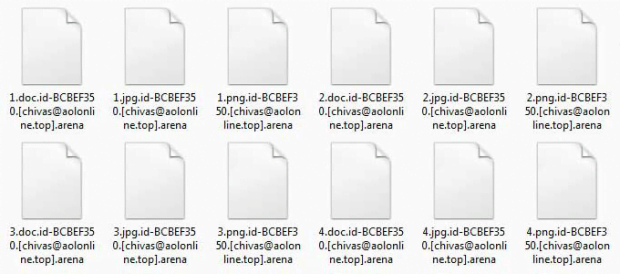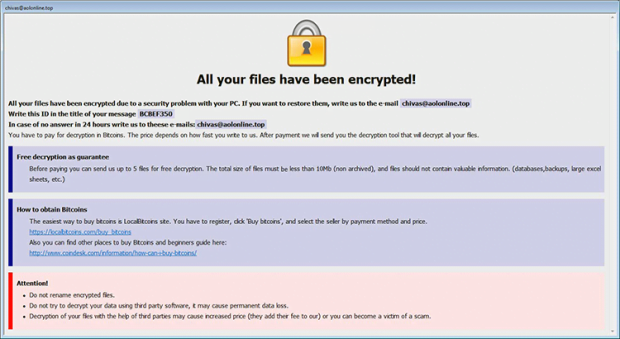Decrypt .arena files virus and remove Arena ransomware

When a blackmail Trojan hits a computer, things get out of hand. The depth of impact depends on how professionally designed a specific strain is, including cryptographic strength and the way the infection handles encryption keys. The new Arena version of the CrySiS/Dharma ransomware is one of the ransomware species you don’t want to encounter. It’s well-architected and not decryptable for free.
Table of Contents
What is the Arena ransomware?
While quite a few recent ransomware strands are all bark but no bite, the Arena edition of CrySiS is both. Just like its predecessor dubbed Cesar, this one leverages RSA and AES cryptographic algorithms immaculately, so decrypting data without a crooks-owned private key is a no go. Every new iteration of this lineage has got unique indicators of breach, which include the extension suffixed to locked files as well as rescue note names. This particular offshoot appends hostage files with the .id-[random].[chivas@aolonline.top].arena. The random part is a victim ID that consists of 8 hexadecimal characters. The email address above is the most commonly reported with this variant, although it can vary too. Different affiliates have different contact details, which explains the variability.
A few other email strings associated with the Arena version of CrySiS/Dharma include btc2017@india.com, black.mirror@qq.com, m.heisenberg@aol.com, macgregor@aolonline.top, sindragosa@bigmir.net, sir.dragcsa@bigmir.net, mandanos@foxmail.com, and gladius_rectus@aol.com. Ultimately, an arbitrary file named Ocean.bmp will morph into an entry similar to Ocean.bmp.id-ACFA91E4.[chivas@aolonline.top].arena. Of course, due to the tweaking via a blend of symmetric and asymmetric crypto standards, none of these files can be opened or accessed in some other way.
As soon as the plagued user starts to realize something is wrong with their data, the Arena virus displays a window encompassing the ransom note named Info.hta. Additionally, it drops the FILES ENCRYPTED.txt document onto the desktop. The contents of these two are different, the HTA edition being much more verbose.
According to the rescue notes, the infected user is supposed to send an email to chivas@aolonline.top, or whatever address is indicated in there. The title of this message should contain the unique victim ID so that the crooks can work out which private RSA key will apply in this case. The bad guys also allow the user to restore up to 5 files for free. These should be under 10Mb in size, shouldn’t be archived or contain any valuable information. In response to the message, the perpetrators will send the size of the ransom and the Bitcoin wallet to submit it. The amount ranges from 0.5 to 1 BTC.
Unlike most ransomware species that are spam-borne, the Arena strain is making the round via RDP. The attackers abuse remote desktop services to gain a foothold on a computer and execute the malicious binary. Upon infiltration, the parasite attempts to delete shadow copies of the user’s files and scans the hard drive and network shares for personal data. The rest of the assault chain has been described above – Arena encrypts the spotted information, modifies filenames and generates ransom notes. To get rid of the infection and try to reinstate files, be sure to follow the tips below.
Arena ransomware automatic removal
Extermination of this ransomware can be efficiently accomplished with reliable security software. Sticking to the automatic cleanup technique ensures that all components of the infection get thoroughly wiped from your system.
1. Download recommended security utility and get your PC checked for malicious objects by selecting the Start Computer Scan option
Download Arena ransomware remover
2. The scan will come up with a list of detected items. Click Fix Threats to get the ransomware and related infections removed from your system. Completing this phase of the cleanup process is most likely to lead to complete eradication of the plague proper. Now you are facing a bigger challenge – try and get your data back.
Methods to restore files encrypted by Arena ransomware
Workaround 1: Use file recovery software
It’s important to know that the Arena ransomware creates copies of your files and encrypts them. In the meanwhile, the original files get deleted. There are applications out there that can restore the removed data. You can utilize tools like Stellar Data Recovery for this purpose. The newest version of the ransomware under consideration tends to apply secure deletion with several overwrites, but in any case this method is worth a try.
Download Stellar Data Recovery Professional
Workaround 2: Make use of backups
First and foremost, this is a great way of recovering your files. It’s only applicable, though, if you have been backing up the information stored on your machine. If so, do not fail to benefit from your forethought.
Workaround 3: Use Shadow Volume Copies
In case you didn’t know, the operating system creates so-called Shadow Volume Copies of every file as long as System Restore is activated on the computer. As restore points are created at specified intervals, snapshots of files as they appear at that moment are generated as well. Be advised this method does not ensure the recovery of the latest versions of your files. It’s certainly worth a shot though. This workflow is doable in two ways: manually and through the use of an automatic solution. Let’s first take a look at the manual process.
-
Use the Previous Versions feature
The Windows OS provides a built-in option of recovering previous versions of files. It can also be applied to folders. Just right-click on a file or folder, select Properties and hit the tab named Previous Versions. Within the versions area, you will see the list of backed up copies of the file / folder, with the respective time and date indication. Select the latest entry and click Copy if you wish to restore the object to a new location that you can specify. If you click the Restore button, the item will be restored to its original location.

-
Apply Shadow Explorer tool
This workflow allows restoring previous versions of files and folders in an automatic mode rather than by hand. To do this, download and install the Shadow Explorer application. After you run it, select the drive name and the date that the file versions were created. Right-click on the folder or file of interest and select the Export option. Then simply specify the location to which the data should be restored.

Verify whether Arena ransomware has been completely removed
Again, ransomware removal alone does not lead to the decryption of your personal files. The data restore methods highlighted above may or may not do the trick, but the ransomware itself does not belong inside your computer. Incidentally, it often comes with other ransomware, which is why it definitely makes sense to repeatedly scan the system with automatic security software in order to make sure no harmful remnants of this ransomware and associated threats are left inside Windows Registry and other locations.
Posted in: KnowledgeBase
Leave a Comment (0) ↓




